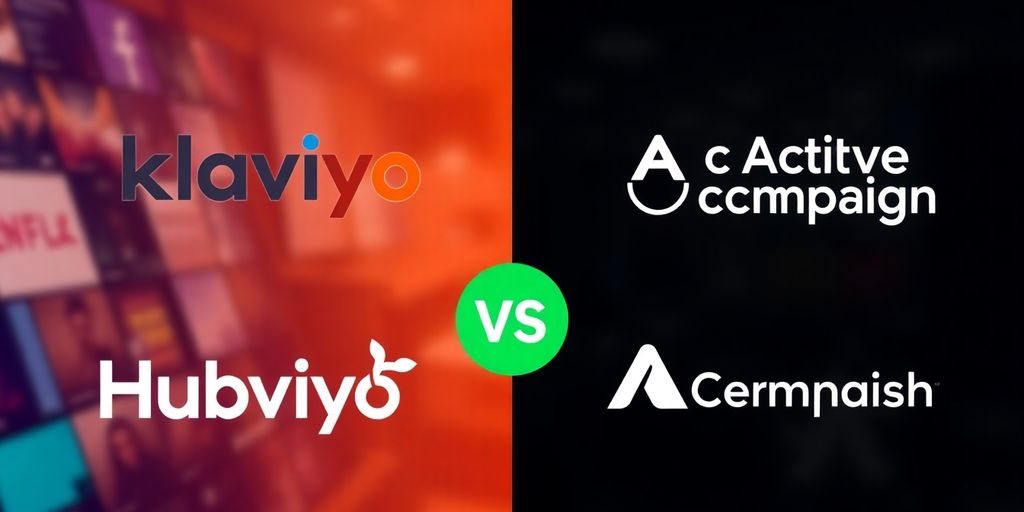Klaviyo vs HubSpot vs ActiveCampaign: The Ultimate Comparison for Ecommerce Success

In the world of eCommerce, choosing the right email marketing platform can make a big difference in your success. Klaviyo, HubSpot, and ActiveCampaign are three popular options, each with its own strengths and weaknesses. This article will break down how these platforms stack up against each other, focusing on their features, pricing, ease of use, and more to help you find the best fit for your business needs.
Key Takeaways
- Klaviyo is tailored for eCommerce, providing advanced analytics and integrations with major online stores.
- HubSpot excels in comprehensive marketing solutions, making it ideal for businesses focused on lead nurturing and content marketing.
- ActiveCampaign offers strong automation features that cater to both eCommerce and service-based businesses.
- Pricing structures vary significantly, with Klaviyo charging based on the number of contacts and ActiveCampaign offering tiered plans.
- User experience differs, with Klaviyo favoring dropdown menus and ActiveCampaign utilizing sidebars for navigation.
Understanding The Platforms: Klaviyo, HubSpot, And ActiveCampaign

Overview Of Klaviyo
Klaviyo is a platform heavily focused on ecommerce businesses. It’s designed to help online stores create personalized marketing experiences. It achieves this through robust data tracking and segmentation capabilities. Think of it as a tool that really wants to understand your customers’ behavior so you can send them the right message at the right time. It’s not just about sending emails; it’s about building relationships and driving sales. Klaviyo’s strength lies in its ability to integrate deeply with ecommerce platforms, making it easy to pull in data about purchases, browsing history, and other customer activities. This data then fuels targeted campaigns and automations.
Overview Of HubSpot
HubSpot is a comprehensive platform that offers a wide range of tools for marketing, sales, and customer service. Unlike Klaviyo, which is laser-focused on ecommerce, HubSpot aims to be an all-in-one solution for businesses of all types. Its Marketing Hub includes features for email marketing, automation, social media management, and content creation. HubSpot also offers a CRM (Customer Relationship Management) system, which helps businesses track and manage their interactions with customers and prospects. This makes it a good choice for businesses that want a unified view of their customer data and a platform that can support their entire customer journey. If you’re looking for something that can handle more than just email, HubSpot’s Marketing Hub might be a good fit.
Overview Of ActiveCampaign
ActiveCampaign sits somewhere in between Klaviyo and HubSpot in terms of its focus. It’s primarily an email marketing and automation platform, but it also offers features for CRM and sales automation. ActiveCampaign is known for its powerful automation capabilities, which allow businesses to create complex and highly personalized customer journeys. It also offers a range of integrations with other tools, making it a flexible option for businesses with diverse needs. While it’s not as specialized for ecommerce as Klaviyo, it offers a good balance of features and flexibility for businesses that want to automate their marketing and sales processes. It’s a solid choice if you need something more robust than basic email marketing but don’t necessarily need all the bells and whistles of a full-fledged CRM like HubSpot.
Choosing the right platform depends heavily on your specific business needs and goals. Consider what’s most important to you: deep ecommerce integration, a comprehensive all-in-one solution, or powerful automation capabilities.
Key Features Comparison: Klaviyo, HubSpot, And ActiveCampaign

Email Marketing Capabilities
Let’s get into the nitty-gritty of what each platform brings to the table when it comes to email. Email marketing is the bread and butter of these platforms, but they each have their own way of doing things. Klaviyo is really focused on e-commerce, so its email features are tailored for that. Think abandoned cart emails, product recommendations, and customer win-back campaigns. HubSpot has a broader focus, so its email tools are more general-purpose but still quite powerful. ActiveCampaign is known for its automation, which extends to its email marketing, allowing for complex, behavior-based campaigns.
- Klaviyo: E-commerce focused templates and segmentation.
- HubSpot: Versatile email designs and marketing automation.
- ActiveCampaign: Advanced automation and personalization options.
Choosing the right platform depends on your specific needs. If you’re running an e-commerce store, Klaviyo might be a natural fit. If you need a more general-purpose solution that integrates with other marketing and sales tools, HubSpot could be a better choice. And if automation is your top priority, ActiveCampaign is worth a look.
Automation Tools
Automation is where things get interesting. ActiveCampaign really shines here, offering some seriously advanced automation capabilities. You can build complex workflows with tons of triggers, conditions, and actions. HubSpot also has strong automation, especially in its Marketing Hub, but it can get pricey. Klaviyo’s automation is more focused on e-commerce scenarios, but it’s still quite effective for things like welcome series and post-purchase flows. If you are looking for AI writing tools to help you with automation, there are many options available.
- ActiveCampaign: Highly customizable automation workflows.
- HubSpot: Robust automation within its marketing hub.
- Klaviyo: E-commerce specific automation sequences.
Segmentation Features
Segmentation is all about dividing your audience into smaller, more targeted groups. Klaviyo excels at this, especially for e-commerce, because it can segment based on purchase history, website activity, and other customer data. HubSpot also has good segmentation, allowing you to create lists based on a wide range of criteria. ActiveCampaign’s segmentation is tied to its automation, so you can create segments that trigger specific workflows. The right email marketing strategy can make all the difference.
- Klaviyo: Granular segmentation based on e-commerce data.
- HubSpot: Broad segmentation options across various data points.
- ActiveCampaign: Segmentation integrated with automation workflows.
Pricing Structures: Klaviyo, HubSpot, And ActiveCampaign
Understanding the pricing of Klaviyo, HubSpot, and ActiveCampaign is key to choosing the right platform for your ecommerce business. Each offers different plans, and the best fit depends on your business size, needs, and budget. Let’s break down the pricing for each.
Klaviyo Pricing Plans
Klaviyo’s pricing is primarily based on the number of contacts you have. This means as your list grows, so does your monthly cost. They offer different tiers with varying features, and you can customize your plan based on your specific needs. Klaviyo has three plan types, and prices range depending on your contact list size.
- Email Plan: Focuses on email marketing features.
- SMS Plan: Adds SMS marketing capabilities.
- Combined Email and SMS Plan: Offers both email and SMS features in one package.
HubSpot Pricing Plans
HubSpot’s pricing is structured around "hubs," such as Marketing Hub, Sales Hub, and Service Hub. Each hub has its own pricing tiers, and you can bundle them together. This can be great if you want an all-in-one solution, but it can also get expensive quickly.
- Free: Limited features, good for getting started.
- Starter: Basic marketing and sales tools.
- Professional: More advanced features, including automation.
- Enterprise: Full suite of features, designed for larger organizations.
ActiveCampaign Pricing Plans
ActiveCampaign offers several plans, each with different features and contact limits. Their pricing is generally more affordable than HubSpot, especially for smaller businesses. They also offer a CRM, which is a plus if you need that functionality. ActiveCampaign offers various plan types. If you’re after email and automation marketing only, you’ll want to pick one of their marketing plans:
- Lite: Basic email marketing and automation.
- Plus: Adds CRM, custom branding, and more integrations.
- Professional: Includes advanced automation, site tracking, and predictive sending.
- Enterprise: Custom solutions with dedicated support and advanced features.
Choosing the right pricing plan involves carefully assessing your current needs and anticipating future growth. Consider which features are essential for your business and how many contacts you expect to have. Don’t forget to factor in the cost of integrations and any additional services you might need.
Ease Of Use: Navigating Klaviyo, HubSpot, And ActiveCampaign
User Interface Comparison
Okay, let’s talk about how these platforms feel to use. It’s a big deal, right? You don’t want to spend hours just trying to figure out where everything is. With Klaviyo, you’re getting a pretty clean interface. It’s focused, especially if you’re coming at it from an e-commerce angle. HubSpot can feel a bit more overwhelming at first. It’s got a lot going on, because it does a lot, but that also means it can take a bit to find what you need. ActiveCampaign? It’s somewhere in the middle. It’s got a good balance of features without feeling totally cluttered. ActiveCampaign utilizes sidebars, while Klaviyo uses dropdown menus for feature-specific settings.
Learning Curve
So, how long will it take you to actually learn these platforms? That’s the real question. Klaviyo is probably the easiest to pick up quickly, especially if you’re already familiar with e-commerce marketing concepts. HubSpot has a steeper learning curve, just because it’s so comprehensive. There’s a lot to learn, but they also have a ton of resources to help you out. ActiveCampaign is manageable, but you’ll probably need to spend some time with their tutorials and documentation to really get the hang of it. It’s not as intuitive as Klaviyo, but not as complex as HubSpot either. If you are looking for AI platforms, make sure to check out all the options.
Customer Support Options
What happens when you get stuck? Customer support is key. All three platforms offer various support options, but the quality and speed can vary. HubSpot is known for having pretty good support, with a lot of documentation and a helpful community. Klaviyo’s support is decent, but sometimes it can take a little longer to get a response. ActiveCampaign also offers good support, but again, response times can vary depending on your plan. Here’s a quick breakdown:
- Klaviyo: Email, chat, and a help center. Response times can vary.
- HubSpot: Phone, email, chat, and extensive documentation. Generally reliable.
- ActiveCampaign: Email, chat, and a knowledge base. Can be feature-rich and overcomplicated for beginners.
Ultimately, ease of use is subjective. What works for one person might not work for another. It really depends on your experience level, your specific needs, and how much time you’re willing to invest in learning a new platform.
Integration Capabilities: Klaviyo, HubSpot, And ActiveCampaign
Choosing the right marketing automation platform isn’t just about features and price; it’s also about how well it plays with your existing tools. Let’s look at how Klaviyo, HubSpot, and ActiveCampaign handle integrations.
Ecommerce Platform Integrations
When it comes to ecommerce platform integrations, Klaviyo shines. It’s built with ecommerce in mind, offering deep, native integrations with platforms like Shopify, Magento, and WooCommerce. This means you can easily pull in customer data, purchase history, and product information to personalize your marketing efforts. HubSpot also integrates with these platforms, but the setup can be a bit more involved, and you might need third-party apps for some advanced features. ActiveCampaign offers integrations as well, but it might require more technical know-how to get everything working smoothly.
Third-Party App Integrations
HubSpot takes the lead here with its extensive app marketplace. You can find integrations for just about anything, from CRM and sales tools to social media management and customer support software. ActiveCampaign also has a good selection of third-party integrations, covering a wide range of marketing and sales needs. Klaviyo’s app ecosystem is more focused on ecommerce-specific tools, which can be a plus if that’s your main focus, but a drawback if you need integrations with other types of software. The breadth of integrations can significantly impact workflow efficiency.
API Access and Customization
All three platforms offer API access, allowing you to build custom integrations and tailor the platform to your specific needs. HubSpot’s API is well-documented and relatively easy to use, making it a good choice for developers. ActiveCampaign’s API is also powerful, but it can be a bit more complex to work with. Klaviyo’s API is focused on ecommerce data, so it’s great for building custom ecommerce integrations, but it might not be as versatile for other types of projects. When considering Klaviyo vs HubSpot, remember that the right choice depends on your technical resources and specific integration needs.
Choosing a platform with robust API access is important if you anticipate needing custom integrations or want to connect the platform with other systems that aren’t natively supported. This flexibility can save you time and money in the long run.
Here’s a quick comparison table:
| Feature | Klaviyo | HubSpot | ActiveCampaign |
|---|---|---|---|
| Ecommerce Integrations | Excellent | Good | Moderate |
| Third-Party Apps | Limited | Extensive | Good |
| API Access | Good | Excellent | Good |
Target Audience: Who Should Use Klaviyo, HubSpot, And ActiveCampaign?
Choosing the right platform really depends on what your business needs. Each of these tools – Klaviyo, HubSpot, and ActiveCampaign – shines in different areas. Let’s break down who benefits most from each.
Best For Ecommerce Brands
Klaviyo is heavily geared towards ecommerce. If you’re selling products online, Klaviyo is often the top choice. It integrates directly with platforms like Shopify, WooCommerce, and Magento, allowing for super-targeted email and SMS marketing based on customer behavior. Think abandoned cart emails, personalized product recommendations, and post-purchase follow-ups. It’s all about using customer data to drive sales. If you want to improve your ecommerce marketing, Klaviyo is a great option.
Best For Service-Based Businesses
HubSpot is a strong choice for service-based businesses. It offers a full suite of tools, including CRM, marketing, sales, and customer service hubs. This makes it easy to manage all aspects of your business from one platform. For example, a consulting firm could use HubSpot to track leads, manage client communications, and automate marketing campaigns. It’s a more general tool than Klaviyo, but that can be a good thing if you need a wide range of features. HubSpot’s pricing plans can be a bit complex, so make sure to evaluate your needs carefully.
Best For Small To Medium Enterprises
ActiveCampaign is a solid pick for small to medium-sized enterprises (SMEs) that need robust automation capabilities. It’s more versatile than Klaviyo, supporting both ecommerce and service-based businesses. ActiveCampaign excels at creating complex automation workflows, allowing you to nurture leads, segment your audience, and personalize your messaging. It’s a good middle ground between Klaviyo’s ecommerce focus and HubSpot’s all-in-one approach. ActiveCampaign’s automation tools are really powerful, but they can take some time to learn.
Ultimately, the best platform depends on your specific needs and goals. Consider your business model, budget, and technical expertise when making your decision. Don’t be afraid to try out free trials or demos to see which platform feels like the best fit.
Performance Metrics: Analyzing Klaviyo, HubSpot, And ActiveCampaign
Alright, so you’ve picked your platform, set up some campaigns, and now you’re probably wondering if all this effort is actually doing anything. Let’s talk about how to measure success with Klaviyo, HubSpot, and ActiveCampaign.
Email Deliverability Rates
First up: are your emails even making it to the inbox? Deliverability is huge. If your emails are landing in the spam folder, it doesn’t matter how amazing your content is. Here’s what to keep an eye on:
- Sender Reputation: This is basically your email address’s credit score. A bad reputation means more emails in spam.
- Authentication: Make sure you’ve set up SPF, DKIM, and DMARC records. These prove you are who you say you are.
- Bounce Rate: A high bounce rate (emails that couldn’t be delivered) can hurt your reputation. Clean your list regularly!
Monitoring deliverability isn’t just a one-time thing. It’s an ongoing process. Keep an eye on your stats and adjust your strategy as needed.
Engagement Metrics
Okay, your emails are getting delivered. Great! But are people actually opening them and clicking on stuff? Here are the key engagement metrics:
- Open Rate: The percentage of people who opened your email. A good open rate varies by industry, but aim for above 20%.
- Click-Through Rate (CTR): The percentage of people who clicked on a link in your email. This shows how relevant your content is.
- Conversion Rate: The percentage of people who completed a desired action (like making a purchase) after clicking a link. This is what really matters!
Here’s a simple table to illustrate:
| Metric | What it means |
|---|---|
| Open Rate | How many people saw your subject line and cared |
| Click-Through | How relevant your content is |
| Conversion Rate | How effective your campaign is |
ROI Analysis
Ultimately, you want to know if you’re getting a return on your investment. Is the money you’re spending on these platforms actually leading to more sales? Here’s how to figure it out:
- Track Your Spending: Know exactly how much you’re spending on the platform itself, plus any related costs (like design or copywriting).
- Attribute Revenue: Figure out which sales came directly from your email marketing efforts. This can be tricky, but most platforms offer tools to help.
- Calculate ROI: Use the formula: (Revenue – Cost) / Cost. A positive ROI means you’re making money!
Focus on the metrics that matter most to your business goals. Don’t get bogged down in vanity metrics that don’t actually impact your bottom line.
Final Thoughts on Choosing the Right Tool
In the end, picking between Klaviyo, HubSpot, and ActiveCampaign really comes down to what you need for your eCommerce business. If you’re all about data and want to personalize your marketing, Klaviyo might be your best bet. It’s built for eCommerce and does a great job with customer data. On the flip side, if you’re looking for a more rounded tool that handles everything from email to CRM, ActiveCampaign could be the way to go. HubSpot is great for those who want a strong focus on lead nurturing and content marketing. So, think about your goals, your budget, and what features matter most to you. Each platform has its strengths, so take your time to find the one that fits your business like a glove.
Frequently Asked Questions
What is Klaviyo best for?
Klaviyo is great for eCommerce businesses that want to use customer data to improve their email marketing.
How does HubSpot differ from Klaviyo?
HubSpot focuses on managing customer relationships and nurturing leads, while Klaviyo is more about data-driven email marketing for online stores.
Can ActiveCampaign be used for non-eCommerce businesses?
Yes, ActiveCampaign can be used by both eCommerce and service-based businesses, making it more versatile.
Which platform is easier to use?
Both Klaviyo and ActiveCampaign are user-friendly, but they have different layouts that may appeal to different users.
What kind of support do these platforms offer?
All three platforms provide customer support, but the quality and availability may vary.
How do their pricing plans compare?
Klaviyo, HubSpot, and ActiveCampaign have different pricing structures, so it’s best to check their websites for the latest details.







Responses